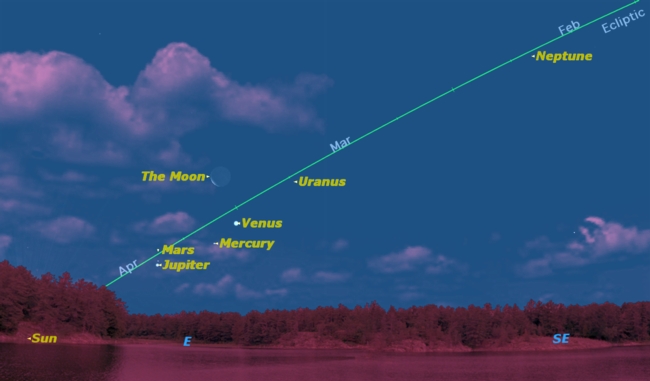Six Planets Now Aligned in the Dawn Sky

If you get up any morning for the next few weeks, you’ll be treated to the sight of all the planets except Saturn arrayed along the ecliptic, the path of the sun through the sky.
For the last two months, almost all the planets have been hiding behind the sun, but this week they all emerge and are arrayed in a grand line above the rising sun. Mercury, Venus, Mars, and Jupiter are visible, and you can add Uranus and Neptune to your count if you have binoculars or a small telescope.
This sky map of the six planets shows how they should appear at dawn to observers with clear weather and an unobstructed view.
Astrologers have always been fascinated by planetary alignments, and the doomsayers of 2012 have been prophesying a mystical alignment on Dec. 21, 2012.
The modern tools of astronomers, such as planetarium software, show otherwise: absolutely no alignment at any time in 2012. But they also reveal a beautiful alignment visible during the month of May this year. [Planet Skywatching Guide for 2011]
Six planets at one time
While astrologers view planetary alignments as foretellers of disasters, modern amateur astronomers look forward to them as nothing more than grand photo ops.
Get the Space.com Newsletter
Breaking space news, the latest updates on rocket launches, skywatching events and more!
If you go out any morning for the next four days, you’ll be treated to a view of the crescent moon and all but one of the naked eye planets.
Because the moon moves rapidly from one morning to the next, it will only be part of the lineup for the next four mornings, but the four naked-eye planets will be there for the next few weeks.
Venus is, as always, the brightest and most visible of the planets, and it can be your guide to spotting the others. About half way between Venus and the rising sun is Jupiter, the second brightest planet.
Mars will be a tiny speck just above Jupiter, and Mercury another tiny speck about half way between Jupiter and Venus. Uranus is slightly more than one binocular field above and to the right of Venus, and Neptune is much farther to the right, about 40 degrees away in Aquarius. The Moon will be just above Venus on Saturday morning, and just above Jupiter and Mars on Sunday morning.
How to photograph the planets
Capturing a photograph of this gathering of the planets couldn’t be easier.
Just about any camera will do, though a camera with a telephoto lens setting will be better. Let the camera’s exposure meter be your guide, though a slight underexposure will help bring out the colors of the dawn sky. [Astrophotography Telescopes for Beginners]
Try to place the silhouette of some foreground object to lend depth to the scene. The best pictures will be on the next few mornings, while the crescent moon is part of the grouping.
This article was provided to SPACE.com by Starry Night Education, the leader in space science curriculum solutions. Follow Starry Night on Twitter @StarryNightEdu.
Join our Space Forums to keep talking space on the latest missions, night sky and more! And if you have a news tip, correction or comment, let us know at: community@space.com.

Geoff Gaherty was Space.com's Night Sky columnist and in partnership with Starry Night software and a dedicated amateur astronomer who sought to share the wonders of the night sky with the world. Based in Canada, Geoff studied mathematics and physics at McGill University and earned a Ph.D. in anthropology from the University of Toronto, all while pursuing a passion for the night sky and serving as an astronomy communicator. He credited a partial solar eclipse observed in 1946 (at age 5) and his 1957 sighting of the Comet Arend-Roland as a teenager for sparking his interest in amateur astronomy. In 2008, Geoff won the Chant Medal from the Royal Astronomical Society of Canada, an award given to a Canadian amateur astronomer in recognition of their lifetime achievements. Sadly, Geoff passed away July 7, 2016 due to complications from a kidney transplant, but his legacy continues at Starry Night.










